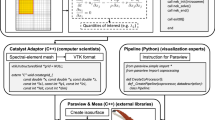Abstract
High-performance computing provides unprecedented capabilities to produce higher resolution 4-D models in a fraction of time. Thus, the need exists for a new generation of visualization systems able to maintain parity with the enormous volume of data generated. In attempting to write this much data to disk, each computational step introduces a significant performance bottleneck, yet most existing visualization software packages inherently rely on reading data in from a dump file. Available packages make this assumption of postprocessing at quite a fundamental level and are not very well suited for plotting very large numbers of specialized particles. This necessitates the creation of a new visualization system that meets the needs of large-scale geodynamic modeling. We have developed such a system, gLucifer, using a software framework approach that allows efficient reuse of our efforts in other areas of research. gLucifer is capable of producing movies of a 4-D data set “on the fly” (simultaneously with running the parallel scientific application) without creating a performance bottleneck. By eliminating most of the human efforts involved in visualizing results through postprocessing, gLucifer reconnects the scientist to the numerical experiment as it unfolds. Data sets that were previously very difficult to even manage may be efficiently explored and interrogated without writing to disk, and because this approach is based entirely on memory distributed across as many processors as are being utilized by the scientific application, the visualization solution is scalable into terabytes of data being rendered in real time.












Similar content being viewed by others
References
Baumgardner JR (1985) Three-dimensional treatment of convective flow in the earth's mantle. J Stat Phys 39:501–511
Beeson B, Barnes DG, Bourke PD (2003) A distributed data implementation of the perspective shear-warp volume rendering algorithm for visualisation of large astronomical cubes. Publ Astron Soc Aust 20(3):300–313
Brodlie K, Duce D, Gallop J, Sagar M, Walton J, Wood J (2004) Visualization in grid computing environments. In: Proceedings of the IEEE conference on visualization'04. IEEE Computer Society, Washington, DC, pp 155–162
Bunge H-P, Richards MA, Baumgardner JR (1997) A sensitivity study of three-dimensional spherical mantle convection at 108 Rayleigh number: effects of depth-dependent viscosity, heating mode, and an endothermic phase change. J Geophys Res 102(B6):11991–12008
Jordan K, Yuen D, Reuteler D, Zhang S, Haimes R (1996) Parallel interactive visualization of 3D mantle convection. Computat Sci Eng IEEE 3:29–37
Liang K, Monger P, Couchman H (2005) Interactive parallel visualization of large particle datasets. Parallel Comput 31(2):243–260. Presented at the Eurographics Symposium on Parallel Graphics and Visualization 2004
Moresi L, Mühlhaus H-B (2006) Anisotropic viscous models of large-deformation Mohr–Coulomb failure. Philos Mag 86:3287–3305
Moresi L, Dufour F, Mühlhaus H-B (2003a) A lagrangian integration point finite element method for large deformation modeling of viscoelastic geomaterials. J Comput Phys 184:476–497
Moresi L, May D, Freeman J, Appelbe B (2003b) Mantle convection modeling with viscoelastic/brittle lithosphere: numerical and computational methodology. In: Proceedings of the international conference on computational science—ICCS 2003, Pt III, lecture notes in computer science, vol 2659. Springer, Berlin, pp 781–787
Moresi L, Quenette S, Lemiale V, Mériaux C, Appelbe B, Mühlhaus H-B (2007) Computational approaches to studying non-linear dynamics of the crust and mantle. Phys Earth Planet Inter 163:69–82. doi:10.1016/j.pepi.2007.06.009. http://adsabs.harvard.edu/abs/2007PEPI..163...69M, Provided by the SAO/NASA Astrophysics Data System
Porter T, Duff T (1984) Compositing digital images. SIGGRAPH Comput Graph 18(3):253–259
Quenette SM, Appelbe BF, Gurnis M, Hodkinson LJ, Moresi L, Sunter PD (2005) An investigation into design for performance and code maintainability in high performance computing. In: May R, Roberts AJ (eds) Proceedings of 12th computational techniques and applications conference CTAC-2004. ANZIAM J 46:C1001–C1016. http://anziamj.austms.org.au/V46/CTAC2004/Quen
Quenette S, Moresi L, Sunter PD, Appelbe WF (2007) Explaining StGermain: an aspect oriented environment for building extensible computational mechanics modeling software. In: HIPS 2007 workshop, 19th IEEE international parallel and distributed processing symposium 2007 (IPDPS 2007), pp 1–8
Schellart WP, Freeman J, Stegman DR, Moresi L, May D (2007) Evolution and diversity of subduction zones controlled by slab width. Nature 446:308–311
Schroeder W, Martin K, Lorensen B (1997) The visualization toolkit: an object-oriented approach to 3D graphics. Prentice Hall, Englewood Cliffs
Stegman DR, Freeman J, Schellart WP, Moresi L, May D (2006) Influence of trench width on subduction hinge retreat rates in 3-D models of slab rollback. Geochem Geophys Geosyst 7(3):1–22
Acknowledgments
This work was carried out within one of the project funded by The Australian Computational Earth Systems Simulator (ACcESS). ACcESS is a major National Research Facility (MNRF) that emcompasses different institutes. The work described here has been developed from scientists from the Monash Cluster Computing (MCC) and software engineers from the Victorian Partnership for Advanced Computing (VPAC). We gratefully aknowledge Greg Watson who designed much of the original VTK modules, Cecile Duboz who lead the maintainance of the framework for nearly 2 years, as well as the Technical Support team at VPAC for installing libfame and Xvfb on several computer clusters, and the Monash Computer Science Summer Vacation Project for their support. We thank Cloudsea Wang and another reviewer for comments, which helped to improve this manuscript.
Author information
Authors and Affiliations
Corresponding author
Rights and permissions
About this article
Cite this article
Stegman, D.R., Moresi, L., Turnbull, R. et al. gLucifer: next generation visualization framework for high-performance computational geodynamics. Vis Geosci 13, 71–84 (2008). https://doi.org/10.1007/s10069-008-0010-2
Received:
Revised:
Accepted:
Published:
Issue Date:
DOI: https://doi.org/10.1007/s10069-008-0010-2




